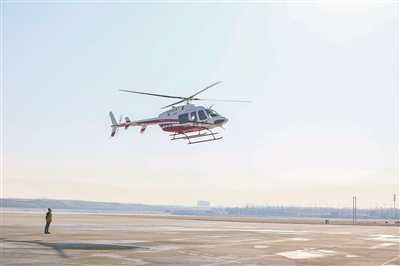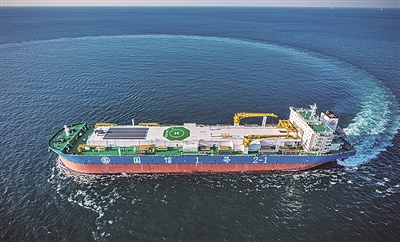Laoshan District to Jiaodong Airport: 15-Minute Helicopter Commute Takes Off
发布时间:2024-12-17 信息来源:Qingdao Government

On the morning of December 15, two Bell 407 helicopters carrying nine passengers departed smoothly from a helipad atop the Dengying Depot of Qingdao Metro Line 4. Following a pre-planned route, the helicopters covered a distance of 51 kilometers in just 15 minutes before landing safely at Jiaodong Airport. This inaugural flight officially launched Qingdao's low-altitude air shuttle service, making it the first city in northern China to introduce an intra-city air transit route. The maiden voyage was witnessed by Member of the Standing Committee of the CPC Qingdao Municipal Committee, Secretary of the Political and Legal Affairs Commission, and the Team Leader of the Municipal Low-Altitude Economy Industrial Chain Cheng Dezhi; along with Wang Bo, fellow Member of the Standing Committee of the CPC Qingdao Municipal Committee and Vice Mayor of Qingdao, who were there to attend the ceremony.
Spearheaded by Qingdao Metro Group—the lead entity of the Qingdao Low-Altitude Economic Alliance—this innovative air shuttle service is the result of strategic collaboration with Qingdao International Airport Group, Qingdao Cloud Century Technology, and Xianglong Aviation. The Qingdao low-altitude air shuttle service introduces a pioneering urban transit model, connecting key city departure points with Jiaodong Airport. This seamless and efficient service offers travel times more than four times faster than traditional ground transportation, marking a significant milestone in the development of low-altitude transportation networks. The service not only represents a breakthrough in urban air transit but also sets a new benchmark for the industry's operations, contributing to the advancement of economic development in the region. Passengers will benefit from city-based low-altitude service centers, where they can relax, complete security checks, and check luggage before boarding helicopters or eVTOLs (electric vertical takeoff and landing aircraft) for direct flights to Jiaodong Airport. This innovative model eliminates the hassle of multiple transfers and long commutes to the airport, significantly reducing travel time and enhancing convenience. Beyond improving efficiency, the service boosts the tourism experience and enriches consumer services, offering a new level of convenience for travelers and driving growth in local tourism and economic sectors.
The successful maiden flight of the Dengying Depot-to-Jiaodong Airport route marks a significant milestone in the integration of low-altitude aviation with traditional industries such as air travel, tourism, and logistics. Building on the foundation of this intra-city air transit model, Qingdao plans to refine operations, standardize procedures, and systematically expand routes. This includes urban commuting, tourism-focused flights, short-distance connections, and overwater routes to enable seamless point-to-point transit within the city and beyond to suburban and intercity destinations. Future developments will include the introduction of more customized urban air shuttle services, and broadening the application of low-altitude transportation. As eVTOL technology advances, Qingdao intends to construct additional urban terminals, service stations, and hubs in central areas, opening new routes and enabling routine low-altitude flights in densely populated zones. These efforts aim to provide residents and visitors with futuristic, efficient, and immersive low-altitude travel experiences.
The Qingdao Low-Altitude Economic Alliance plans to gradually expand its air shuttle operations to encompass diverse services such as low-altitude tourism, aerial rescue, and logistics, creating a complementary and sustainable low-altitude economic ecosystem. With Qingdao's rich tourism resources, the Alliance will be able to introduce aerial sightseeing tours that offer breathtaking views of the city's iconic mountains, sea, islands, and urban landscapes. The low-altitude routes will also function as an instrumental addition to emergency response, handling routine operations and providing rapid reaction capabilities for rescue missions when alerts are received. Additionally, the network will support efficient, high-speed cargo transport, utilizing the air routes to enhance logistics services.



